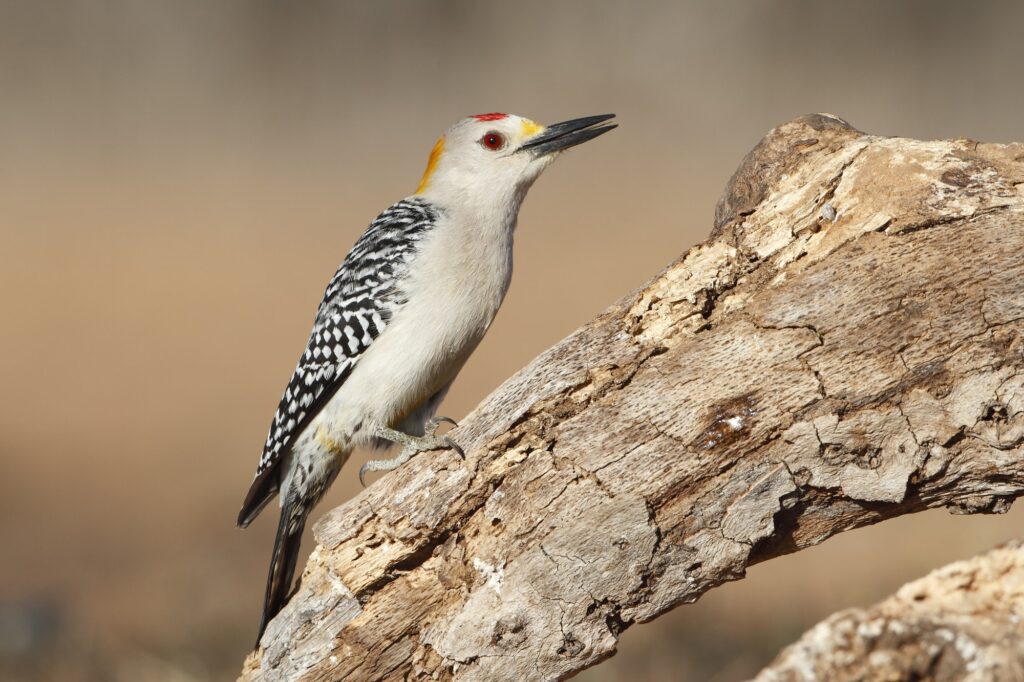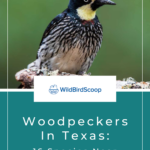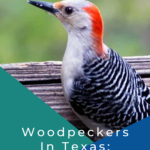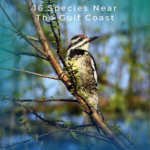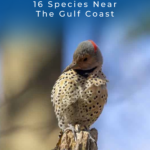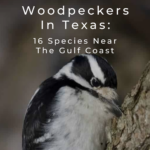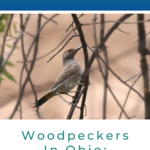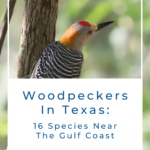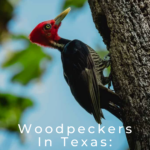A major state in the South of the United States, Texas is the second-largest state after Alaska and ranks second in population density after California. Its climate is varied, as it’s located at the center of several climatic zones.
This huge land is home to an astounding 213 species of reptiles, around 65 species of animals, as well as an incredible number of bird species that amounts to 590 diverse types.
Among the many birds in Texas are 16 known woodpecker species. One of them is believed to be extinct, and another needs further proof of its presence. You can enjoy birdwatching in the woods, the gulf coast, or in one of the numerous state parks in the Lone Star state.
Lewis’s Woodpecker

- Scientific Name: Melanerpes lewis
- Length: 10.2 – 11.0 inches
- Weight: 3.1 – 4.9 ounces
- Wingspan: 19.3 – 20.5 inches
With its purplish-pink stomach feathers, Lewis’s woodpecker is among the rare woodpecker species. But that’s not its only unique physical trait; it also has a greenish tuft of feathers on its head. The rest of its body is greenish-black with some red patches on its head and underbelly. It’s also one of the largest woodpeckers, so between its color and size, Lewis’s bird is rather difficult to miss.
Lewis’s woodpeckers are omnivores that feed on insects, fruits, acorns, and nuts, and though they are woodpeckers, they’re more commonly found foraging like a flycatcher, snatching food from midair.
It’s not a very sociable bird, so you might look for it in the trees rather than in suburban backyards.
Red-Headed Woodpecker
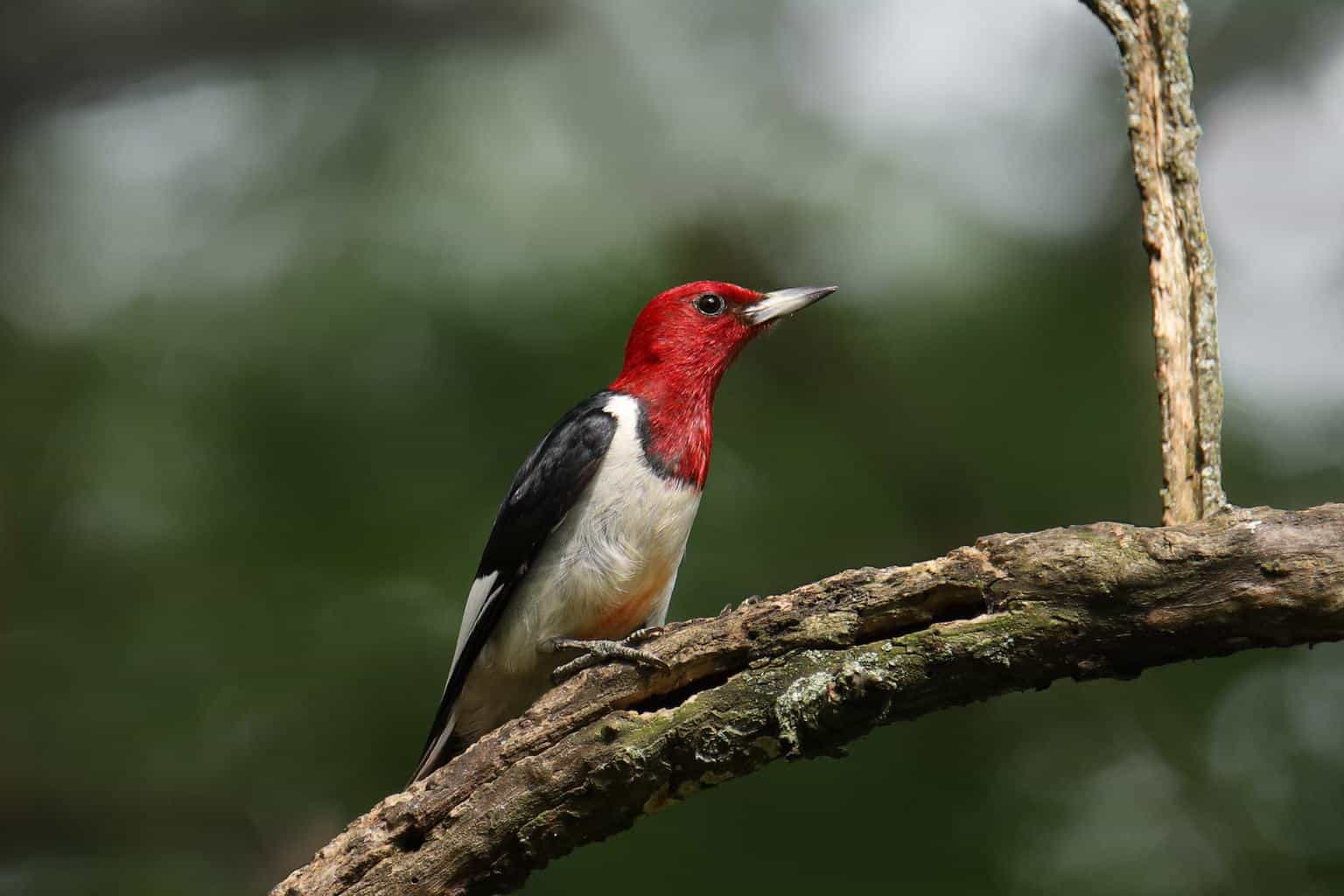
- Scientific Name: Melanerpes erythrocephalus
- Length: 7.5 – 9.1 inches
- Weight: 2.0 – 3.2 ounces
- Wingspan: 16.5 inches
The red-headed woodpecker is, as the name implies, characterized by a prominent red head. It has a black body with white patches on its belly and wings. This medium-sized bird is in a perpetual state of motion, always looking for food.
These woodpeckers are quite noisy, and many birdwatchers claim that they can recognize them from the sound of their shrill calls. You can spot these birds in the forests either looking for food or stuffing the acorns they foraged into the hollow bark of a tree. Find them spending the winter months in Eastern Texas.
They like shorter trees that let them forage for insects on the ground, as well as up in the air. They also enjoy the fruits that they can gather from nearby bushes.
Acorn Woodpecker
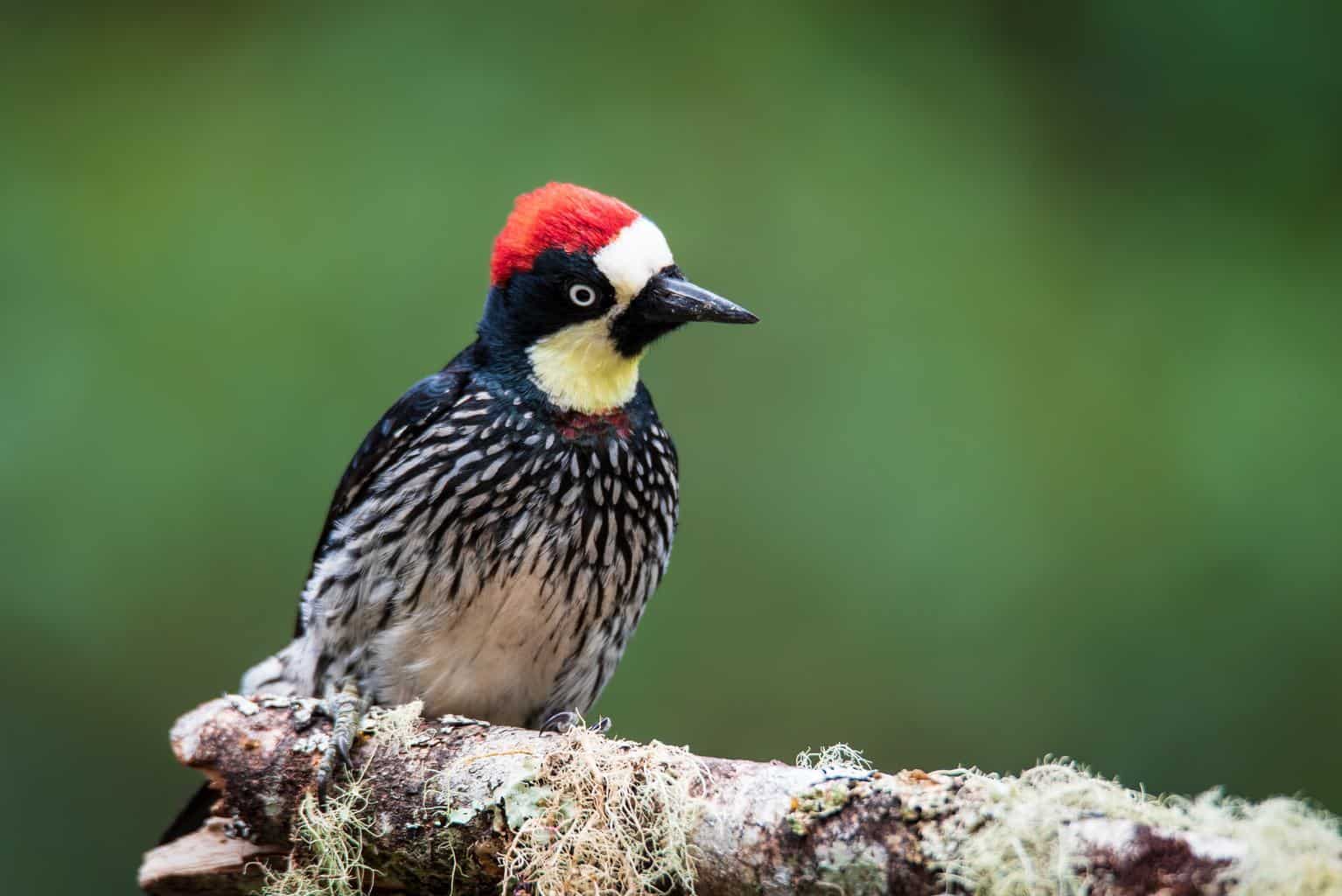
- Scientific Name: Melanerpes formicivorus
- Length: 7.5-9.1 inches
- Weight: 2.3-3.2 ounces
- Wingspan: 13.8-16.9 inches
The acorn woodpecker is medium-sized but rather plump, with a body that’s mostly dark except for the white patches on its throat and belly. What sets off the bird’s stark black and white color scheme is a small red highlight like a cap on its head.
They mostly reside in the southwest areas of North America year-round and are pretty easy to find if you’re trekking through a pine forest. This species of woodpeckers will most likely be spotted wedging acorns into tree cavities for later.
While its appearance may not be too distinctive, you can recognize it from its call, which sounds a lot like a laugh! Acorn woodpeckers live in cooperative families that take care of the nests together.
Golden-Fronted Woodpecker
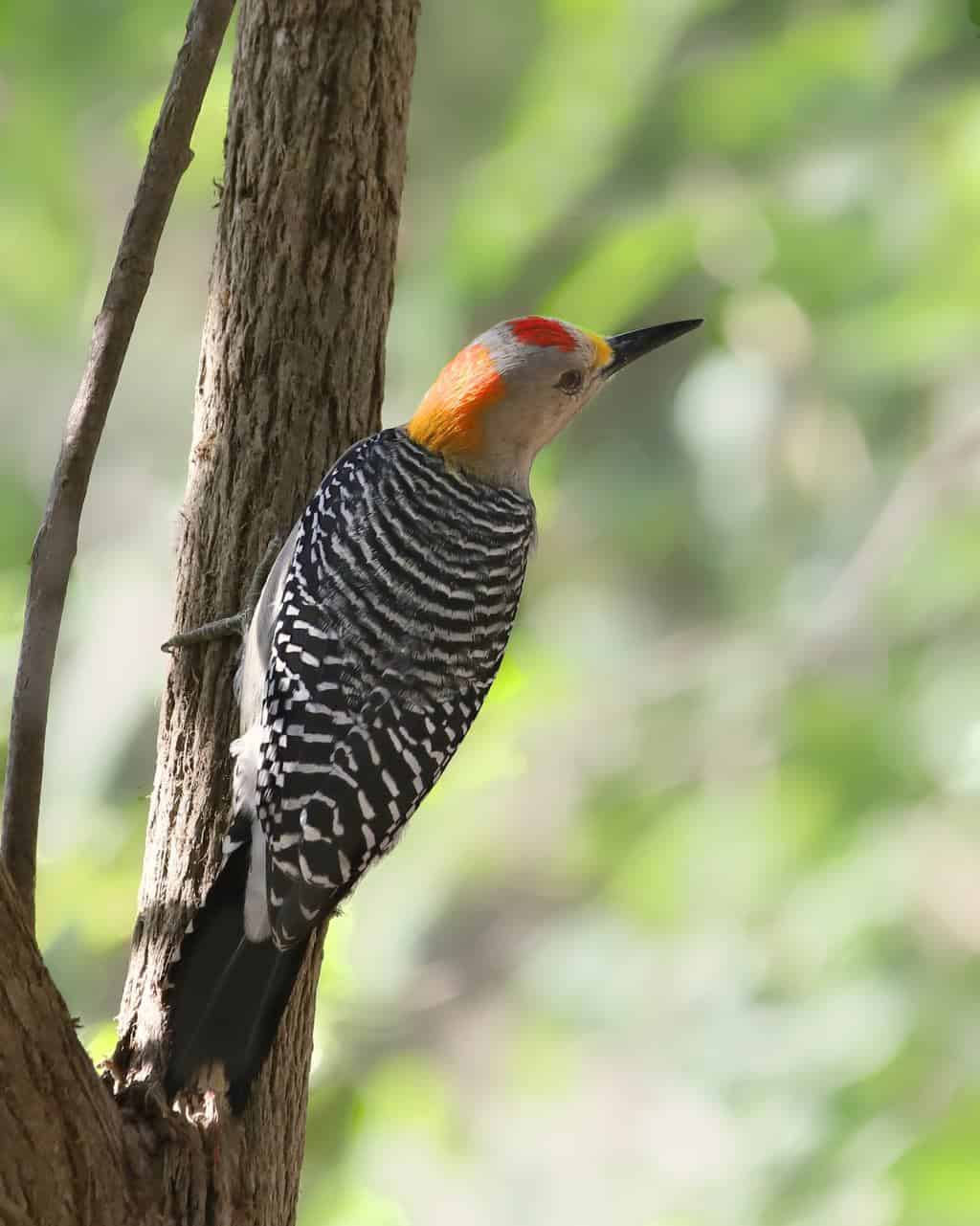
- Scientific Name: Melanerpes aurifrons
- Length: 8.7-10.2 inches
- Weight: 2.6-3.5 ounces
- Wingspan: 16.5-17.3 inches
The rather slim Golden-fronted woodpecker is abundant around Central Texas, and thanks to the clear golden-yellow markings on the back of its head, you can easily spot it in the woods.
Golden-fronted woodpeckers prefer pecan, mesquite, and oak trees, but it’s not uncommon to find both the males and females of this species drilling nesting cavities in telephone poles or inside bird boxes.
This woodpecker feasts on grasshoppers, but wouldn’t turn down a lunch of ants or beetles. It’s also known to eat acorns, berries, and corn.
Red-Bellied Woodpecker

- Scientific Name: Melanerpes carolinus
- Length: 9-10.5 inches
- Weight: 2-3.2 ounces
- Wingspan: 15-18 inches
You’d expect the red-bellied woodpecker to sport a bright red patch of feathers on its stomach, but this species of woodpeckers only has a small tuft of crimson feathers on its belly and a much richer red plumage on its head. The rest of its body is greyish-white, while its back and wings have intricate black and white patterns.
Red-bellied woodpeckers have many natural predators like hawks, snakes, and even cats, especially, since these birds live in damaged or decaying trees. It’s a courageous woodpecker though and defends its nest valiantly, even going so far as to charge its attackers.
The red-bellied woodpecker is common in the eastern woodlands of Texas, mostly in old oak or young pines. If you’re lucky, one of these birds might venture from the forest and make its way to your backyard bird feeders.
Williamson’s Sapsucker
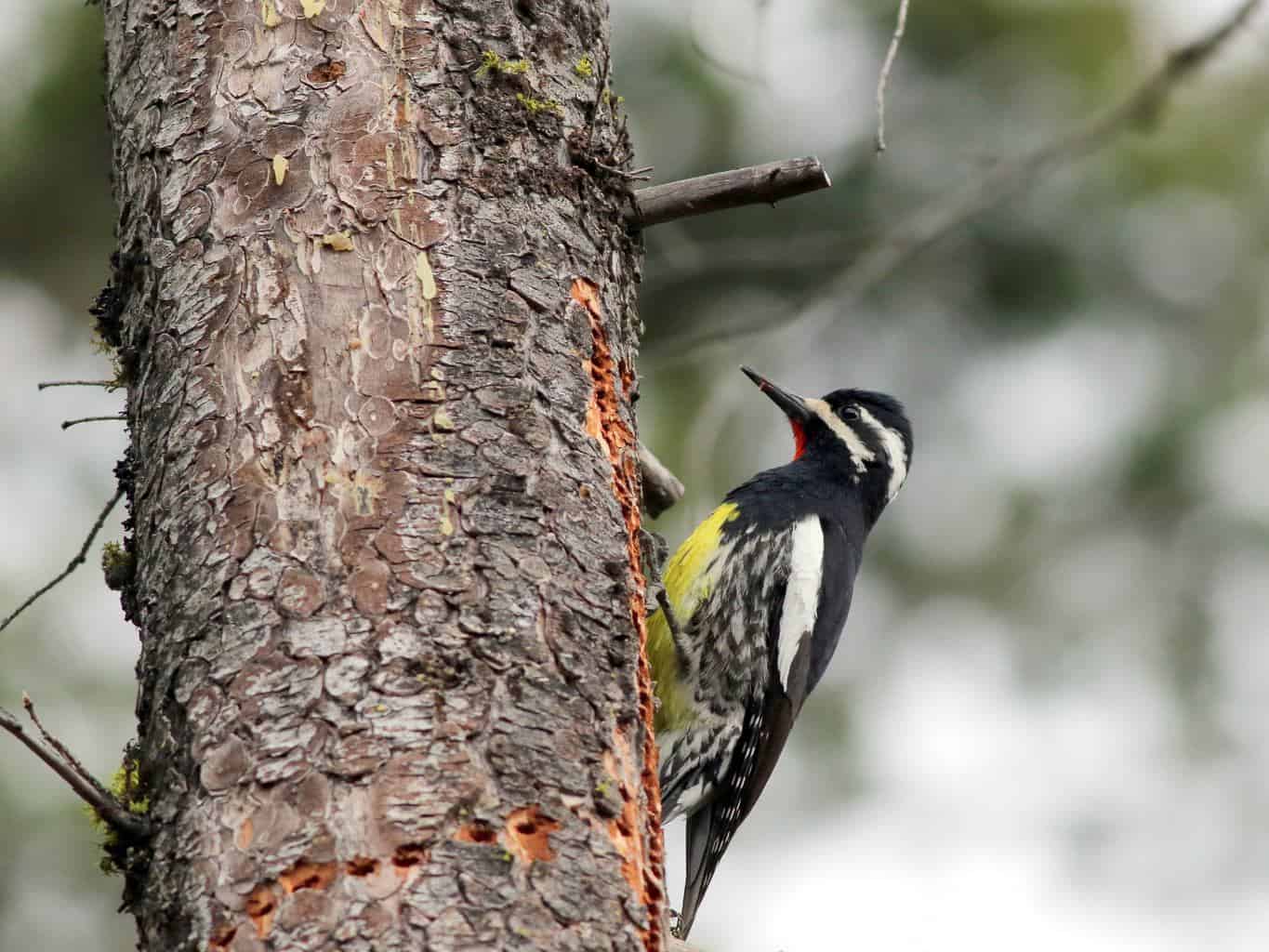
- Scientific Name: Sphyrapicus thyroideus
- Length: 8.3 – 9.8 inches
- Weight: 1.6 – 1.9 ounces
- Wingspan: 17 inches
A male and female Williamson’s sapsucker look so different that ornithologists first thought they were two entirely different species. The male is easier to spot than the female, with its bright red throat and yellow belly. The females are harder to distinguish, as they look much less remarkable.
Williamson’s sapsuckers live as close to their food as possible, which is fir or coniferous tree bark. Their diet consists primarily of the sticky sap they extract, but during breeding season, they also like to eat ants and other insects.
Unfortunately, this species of woodpeckers does not have a large population across the United States, and they can only be seen in Texas outside of their breeding season, so spotting one or two of these birds is rare. In fact, they’ve only ever been spotted in the northwest portion of the state.
Yellow-Bellied Sapsucker
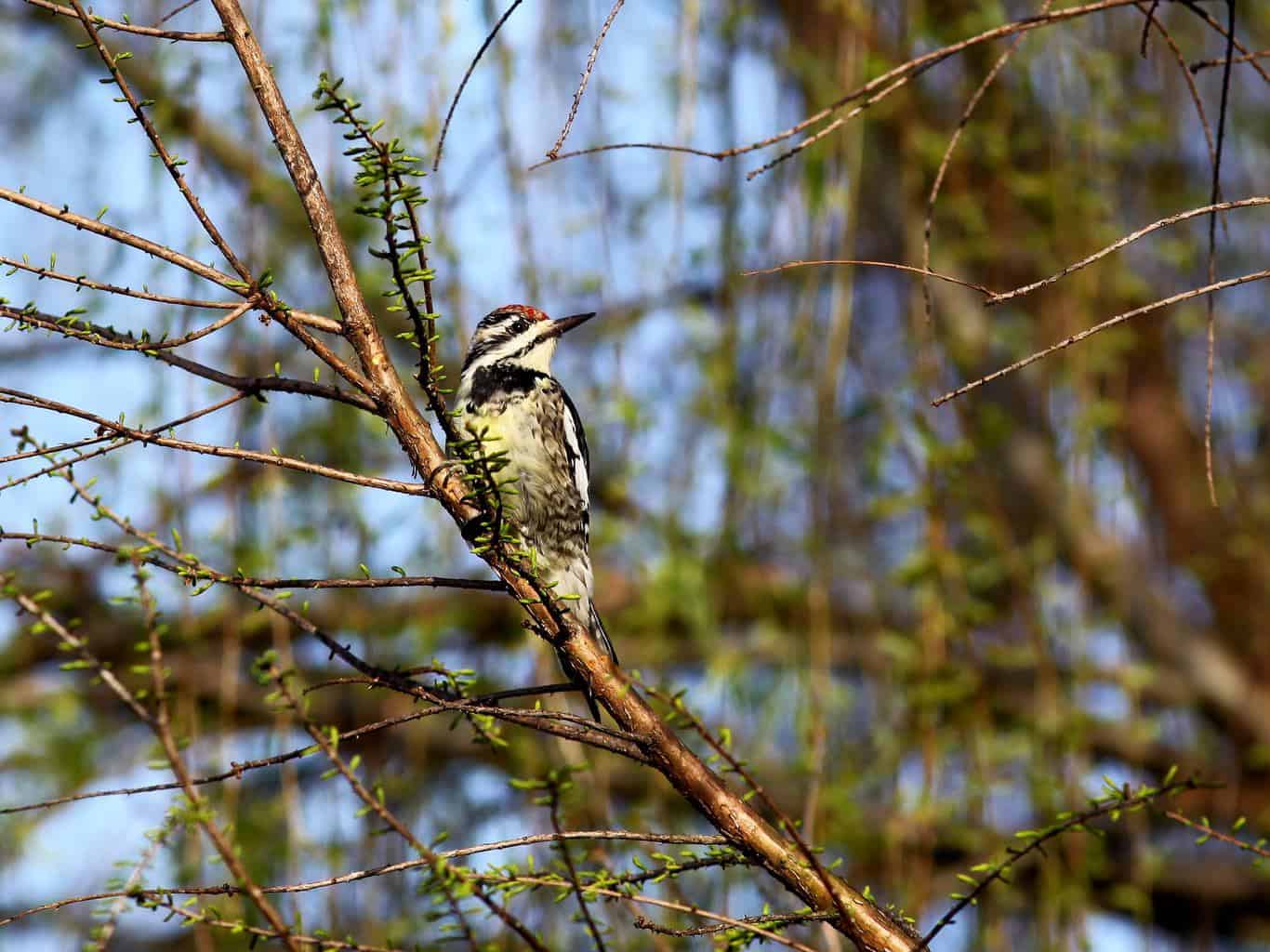
- Scientific Name: Sphyrapicus varius
- Length: 7.1 – 8.7 inches
- Weight: 1.5 – 1.9 ounces
- Wingspan: 13.4 – 15.8 inches
Look for the yellow-bellied sapsucker in the north and eastern areas of North America. These birds wear black and white feathers and sport a bright red crown, but since those are common characteristics of several woodpecker species, the yellow tuft of feathers on their bellies is a tell-tale identifier.
The males are further distinguishable by a red stripe on their throats that females of the species don’t have.
The best time to find these woodpeckers in Texas is outside of breeding season, and the best place is in high conifer trees. Their second-best location is a hollow inside any available tree, which makes sense since they feed on sap.
Though sap is its food of choice, the yellow-bellied sapsucker wouldn’t say no to nuts and fruits if they become available and will occasionally eat suet from bird feeders.
Red-Naped Sapsucker
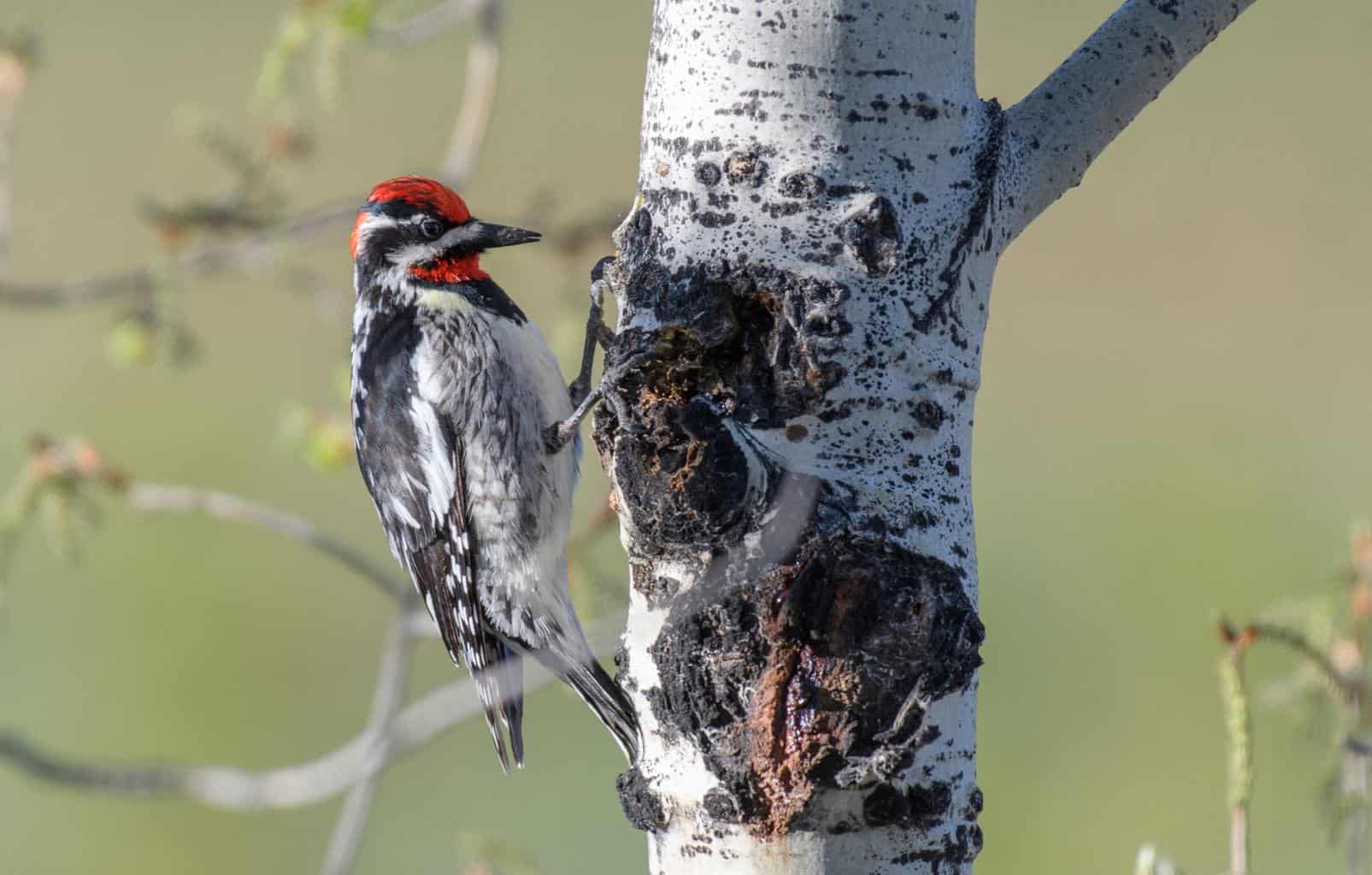
- Scientific Name: Sphyrapicus nuchalis
- Length: 7.5 – 8.3 inches
- Weight: 1.1 – 2.3 ounces
- Wingspan: 16.1 – 16.9 inches
Red-naped sapsuckers can be found in North American mixed forests, including willow, aspen, birch, or fir forests. If you’re in one of those areas, look for the birds with a red patch on their heads and throats, white markings on their wings, and pointed beaks.
These birds migrate to the south looking for warmth, so you’ll only find them on the western edge of Texas during the winter months. These birds use their tongues to sip sugary sweet sap, but they’ll also forage on living and dead trees to dig out insects to eat.
They’re friendly birds, so they are easily found in suburban areas, and if you provide bird feeders in your backyard, you just might make a red-naped woodpecker friend.
Red-Breasted Sapsucker
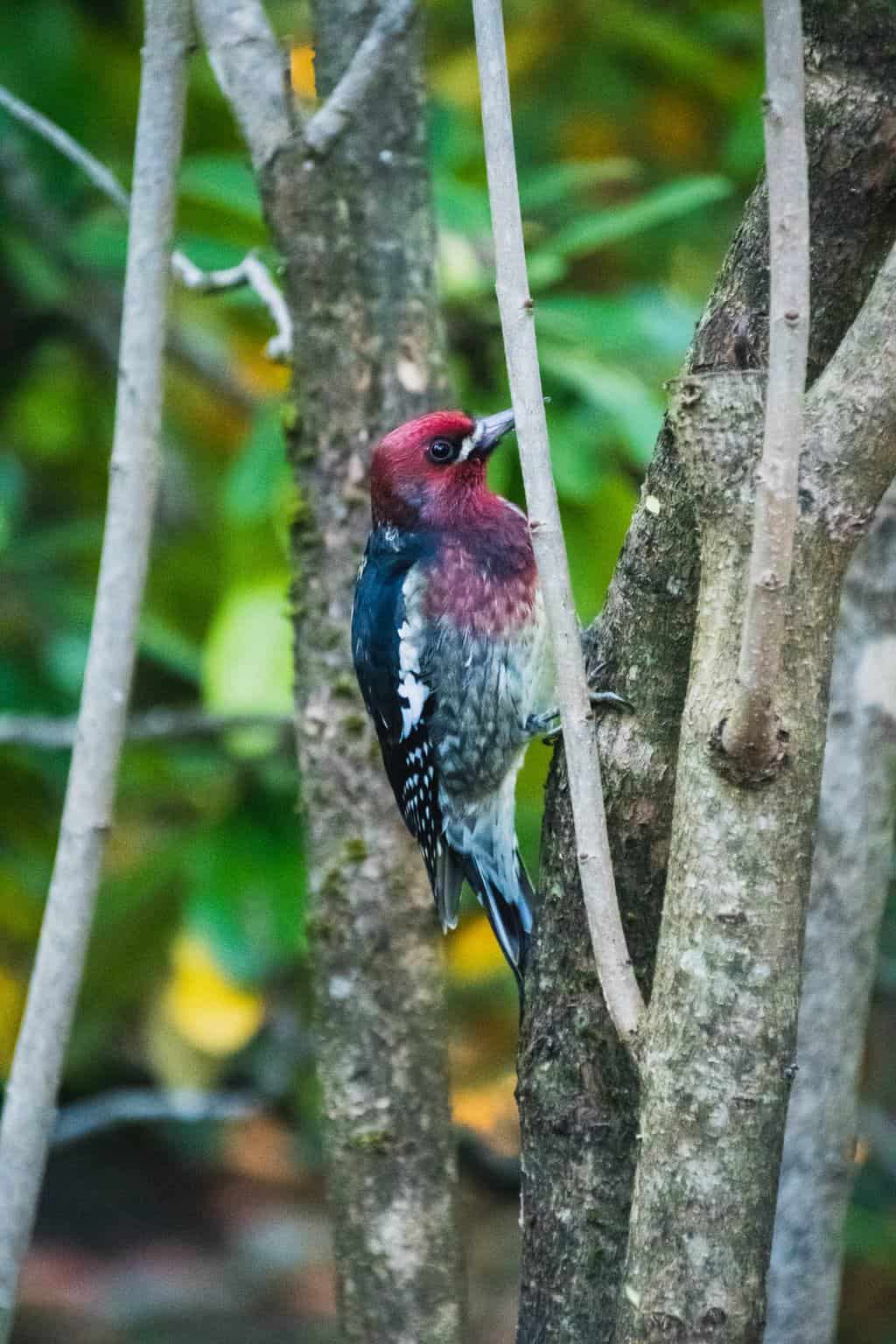
- Scientific Name: Sphyrapicus ruber
- Length: 7.9-8.7 inches
- Weight: 1.9-2.2 ounces
- Wingspan: 14.6-16.0 inches
The red-breasted sapsucker has a clear resemblance to several other woodpecker species because its distinguishing marks are a red head, plus black and white markings on its wings. These birds are known to breed with yellow-bellied sapsuckers as well as red-naped sapsuckers, which creates plenty of commonalities between their varieties.
Just like other sapsuckers, the red-breasted species drills neat rows of tiny holes in tree bark, then returns to them later to sip sap. They also stay true to the woodpecker name and use their bills to dig insects out of tree bark.
The migratory bird has rather unpredictable patterns, which is why to this date, the presence of this woodpecker in Texas still needs to be referenced and substantiated.
Downy Woodpecker
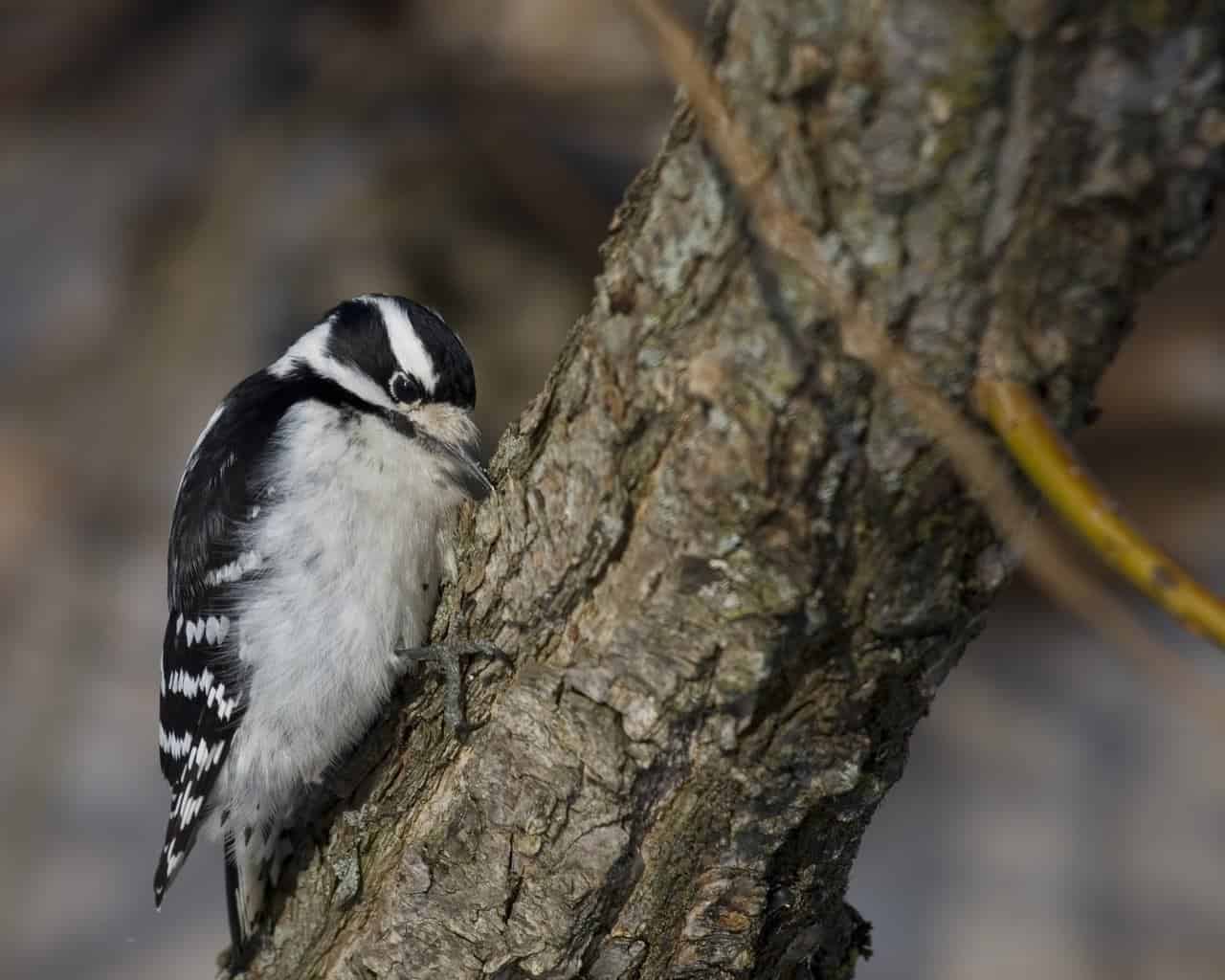
- Scientific Name: Dryobates pubescens
- Length: 5.5 – 6.7 inches
- Weight: 0.7 – 1.0 ounces
- Wingspan: 9.8 – 11.8 inches
Downy woodpeckers are small birds that have plenty in common with hairy woodpeckers, ladder-backed woodpeckers, and red-cockaded woodpeckers. The spotting on its tail is probably the most dependable way to tell it apart from the others.
The downy woodpecker, who can be seen across most of North America year-round, is a bark forager, pecking about on small branches looking for bugs to eat.
Downy woodpeckers can be found in many different places, like parks, orchards, and suburban areas. It could even take residence in your backyard. They’re not always welcome visitors though, with their shrill calls and continuous drumming!
Ladder-Backed Woodpecker
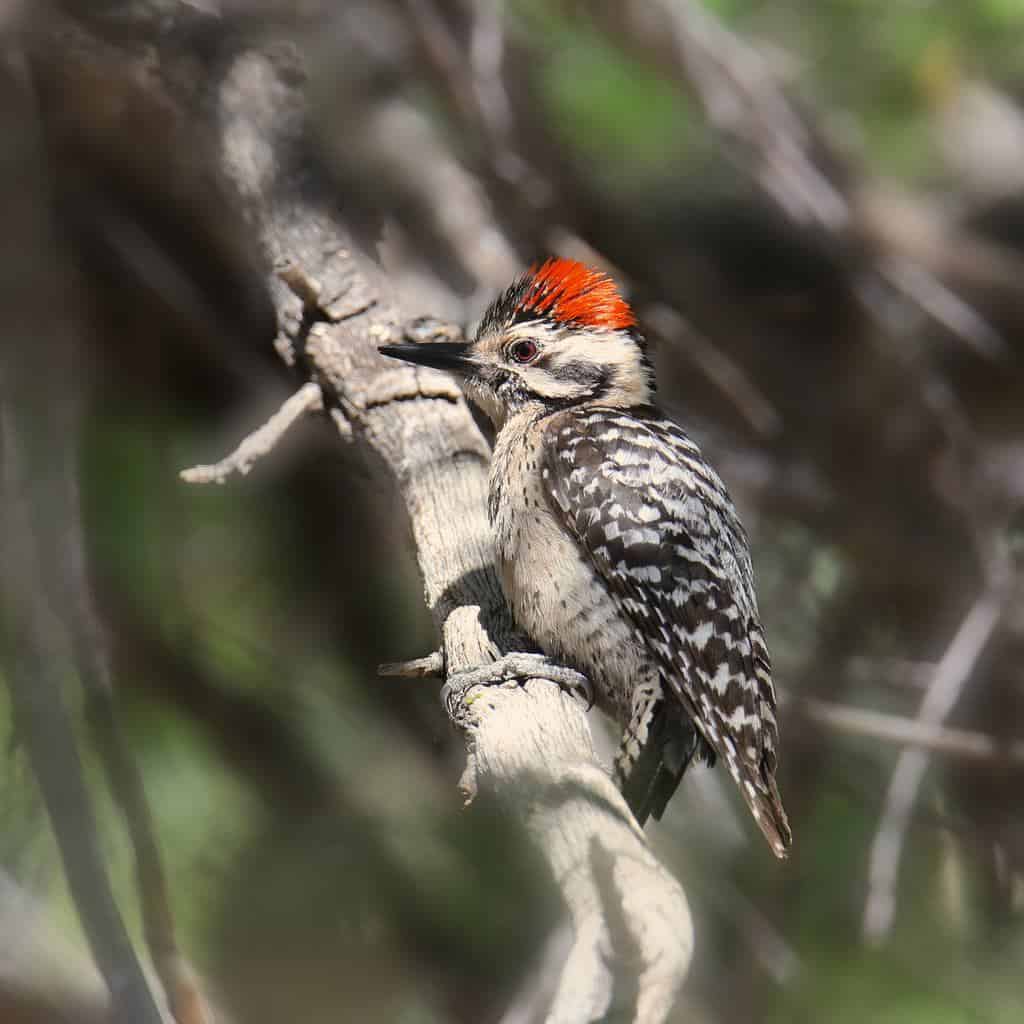
- Scientific Name: Dryobates scalaris
- Length: 6.3-7.1 inches
- Weight: 0.7-1.7 ounces
- Wingspan: 13 inches
You probably already guessed that the ladder-backed woodpecker sports a barred, ladder-like pattern on its back, but did you know it boasts a checkered pattern on its wings?
These birds, formerly called cactus woodpeckers, can be found in brushy thickets, arid spots within a giant cactus, or inside hollowed tree trunks. They reside in these habitats all year-round, so there’s a good chance you’d come across one, especially if you find yourself in Central and West Texas.
The ladder-backed woodpecker has a chisel-like bill, which it puts to good use as it bores through the trees in search of insects. It also feeds on larvae and the occasional fruit it finds in its dry surroundings.
Red-Cockaded Woodpecker
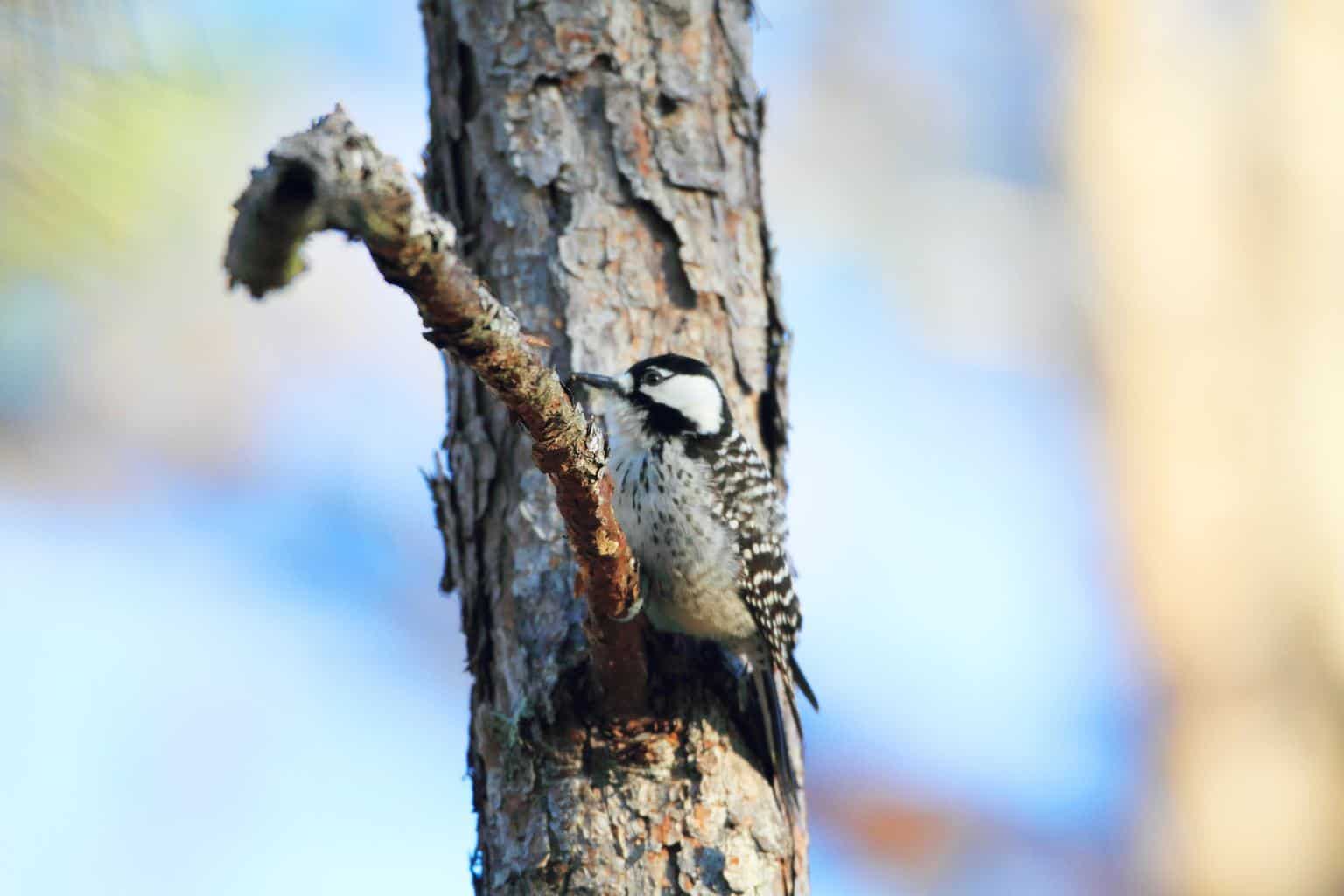
- Scientific Name: Dryobates borealis
- Length: 7.1–9.1 inches
- Weight: 1.4–2.0 ounces
- Wingspan: 13–16 inches
There’s nothing particularly special about the appearance of the red-cockaded woodpecker, except for a black cap and the red cockade on both sides of the males’ faces.
This woodpecker likes to live in groups, where several members are codependent in nesting, childcare, and finding food. They take residence in large trees or cornfields, where they can feast on their favorite insects like cockroaches, ants, beetles, and spiders.
Hairy Woodpecker
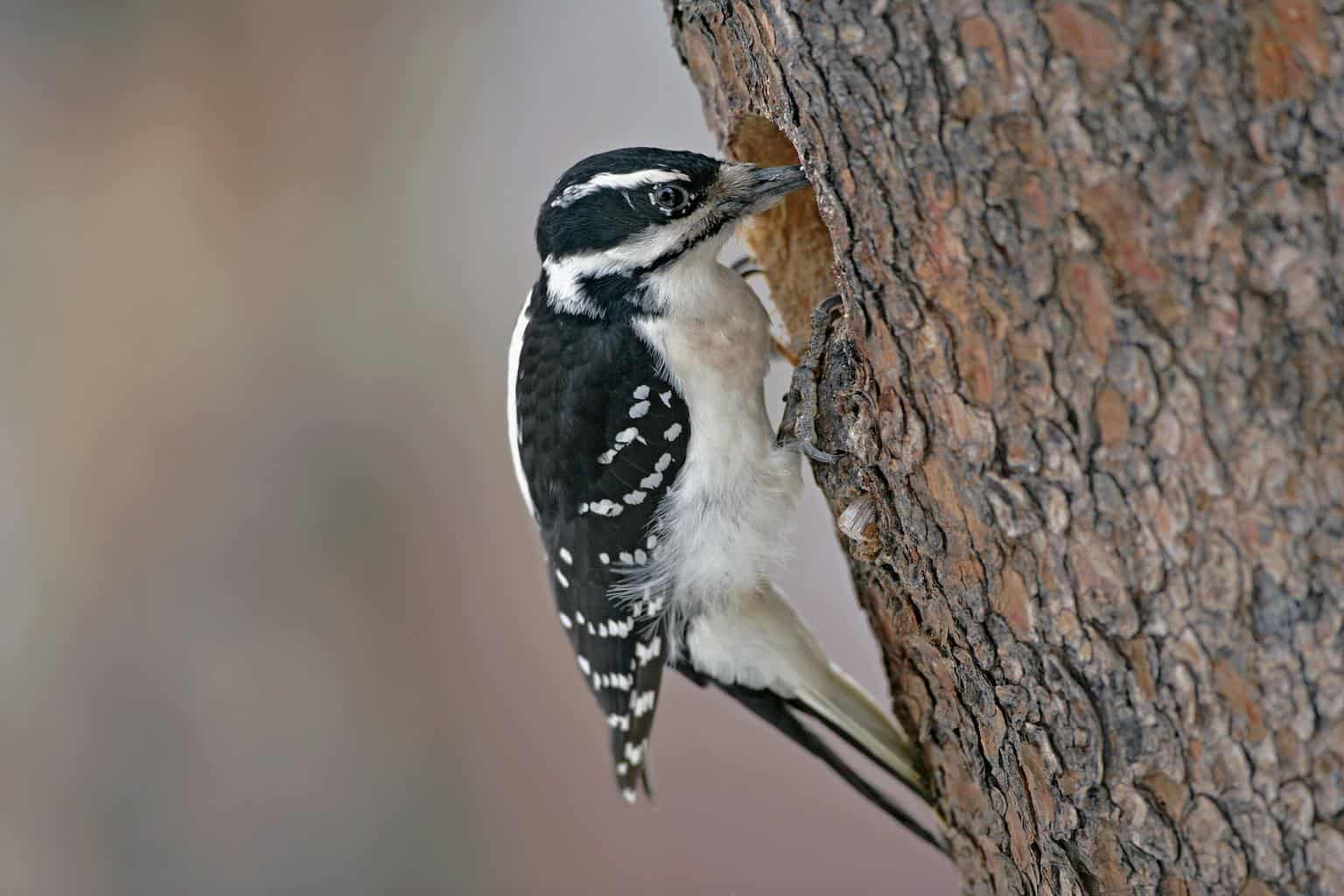
- Scientific Name: Dryobates villosus
- Length: 7.1 – 10.2 inches
- Weight: 1.4 – 3.4 ounces
- Wingspan: 13.0 – 16.1 inches
Anyone can see that hairy woodpeckers are quite similar to downy woodpeckers, but only the seasoned birdwatcher pays close enough attention to correctly differentiate the two species. Just note that hairies are the larger of the two, and you’ll be identifying them in no time. And just like their downy cousins, hairies aren’t picky about living arrangements or food.
The hairy woodpecker makes his home in the majority of the North American continent and spends his days in large trees, foraging and drumming. Occasionally, these birds will feed at the bases of trees, too, and even on the ground.
Farmers often welcome these woodpeckers to their property with open arms, as the hairy woodpecker is known to feed on a crop insect that’s responsible for significant losses each year.
Northern Flicker

- Scientific Name: Colaptes auratus
- Length: 11.0 – 12.2 inches
- Weight: 3.9 – 5.6 ounces
- Wingspan: 16.5 – 20.1 inches
There are two varieties of the Northern Flicker that make their homes in Texas during the year — red-shafted and yellow-shafted. Though the varieties of this species are different, they share the same fundamental traits: a brown color overall, a white rump, and black spots all over its body. The shaft, or patch of feathers underneath the bird’s tail and wings, are red for western birds and yellow for eastern.
The northern flicker is a ground-feeder who constantly feasting on insects, especially ants, and when they’re in trees, they sit straight up instead of leaning on their tails.
Northern flickers don’t typically make a habit of visiting backyards, but they might do so occasionally; if you’re lucky, one might show up for a dip in your bird bath.
Pileated Woodpecker
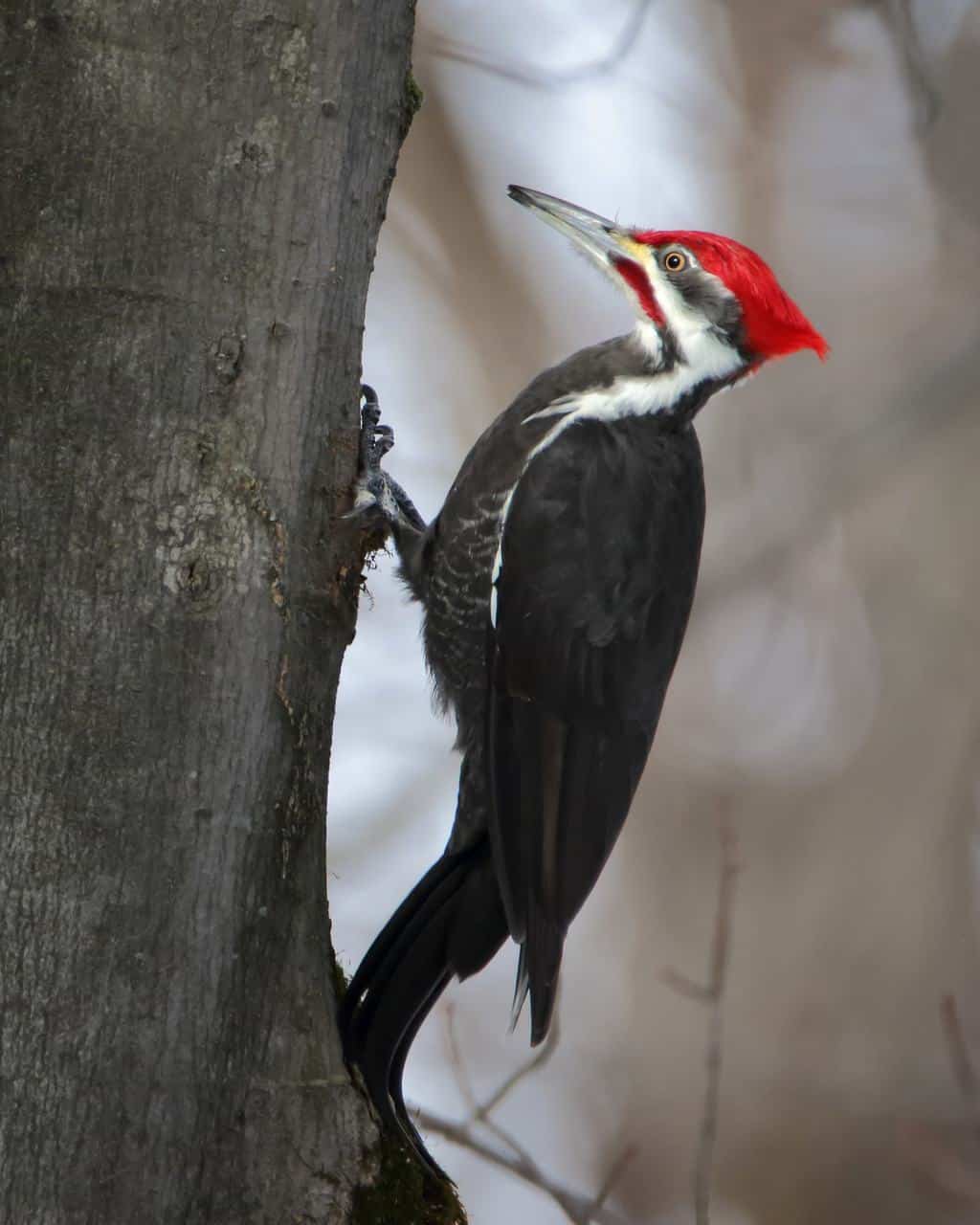
- Scientific Name: Dryocopus pileatus
- Length: 16-19 inches
- Weight: 11 ounces
- Wingspan: 26-30 inches
The pileated woodpecker is a large, inky black bird with a red crest and a pointed tail. It’s mainly found in forests where there are aging or damaged trees. That’s because it fancies wood-boring beetles over other insects. However, it doesn’t mind feeding on nuts and fruits when it finds them.
Male pileated woodpeckers sport a crimson stripe on their cheeks, and as it soars through the sky, you’ll see the pileated woodpecker’s white underwings.
These birds can usually be found in the eastern part of Texas year-round and are friendly enough to visit your backyard. Fill a feeder with suet for them, or if it’s breeding season, consider hanging a nest box.
Ivory-Billed Woodpecker
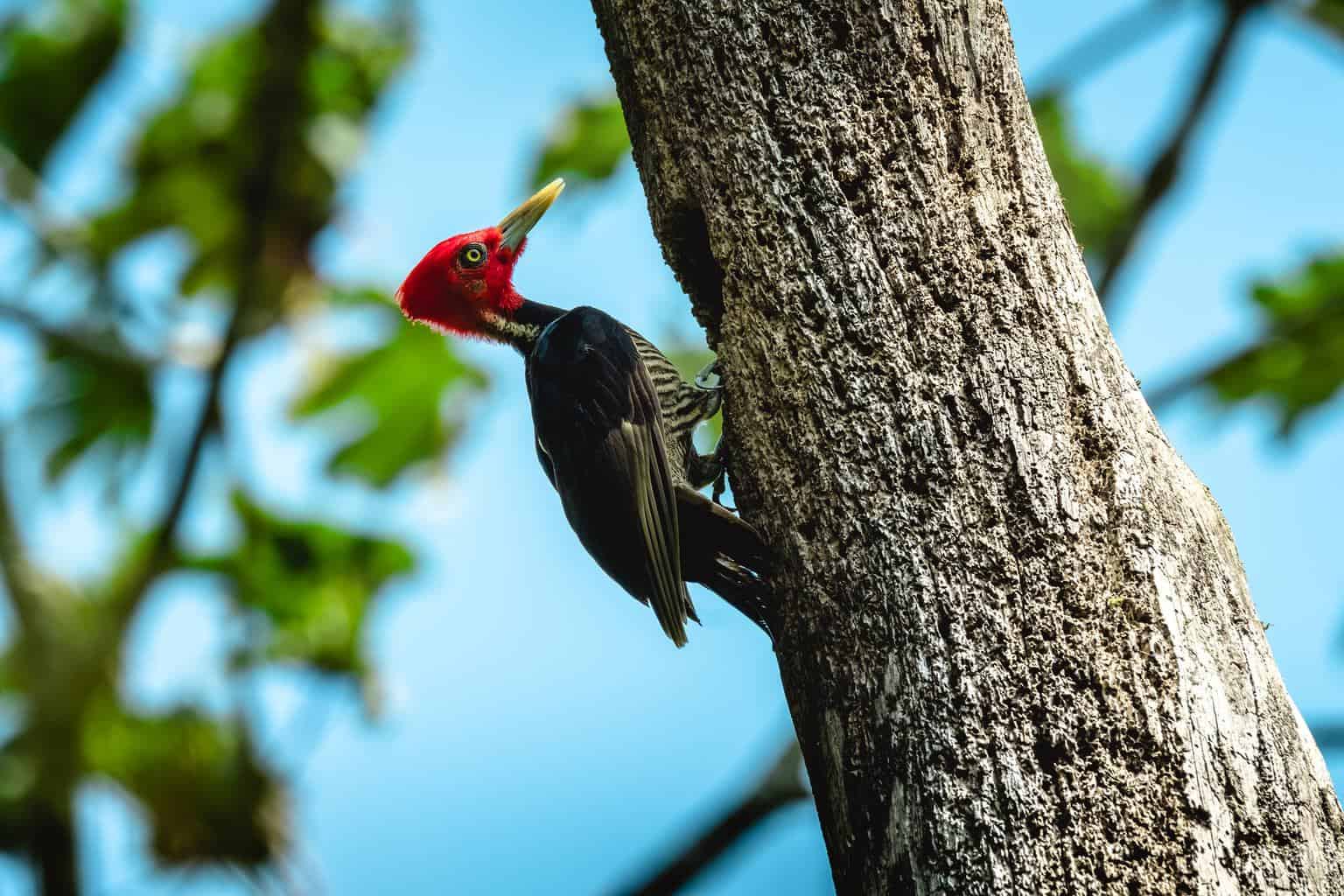
- Scientific Name: Campephilus principalis
- Length: 18.1 to 20.1 inches
- Weight: 15.9-20.1 ounces
- Wingspan: 29.9-31.5 inches
According to the American Birding Association, the Ivory-billed woodpecker might be an extinct bird, thanks to a major loss of its forest habitat. However, it was mentioned in several references as part of the wildlife in Texas, so we had to include it here.
It’s actually one of the largest woodpeckers worldwide, ranking the third largest species in the world and the largest found north of Mexico.
These birds, if they can still be spotted, are known for the two white stripes going down their black bodies and pale white bills.
In Conclusion
We hope you find our guide to woodpeckers in Texas helpful on your birdwatching excursions. Now that you know a few of the best ways to identify them, their traits, and preferred habitats, you just might spot one or two of them the next time you’re out.
And while you’re scouting woodpeckers, keep your eyes peeled for the absolutely unique and stunning red birds of Texas!

